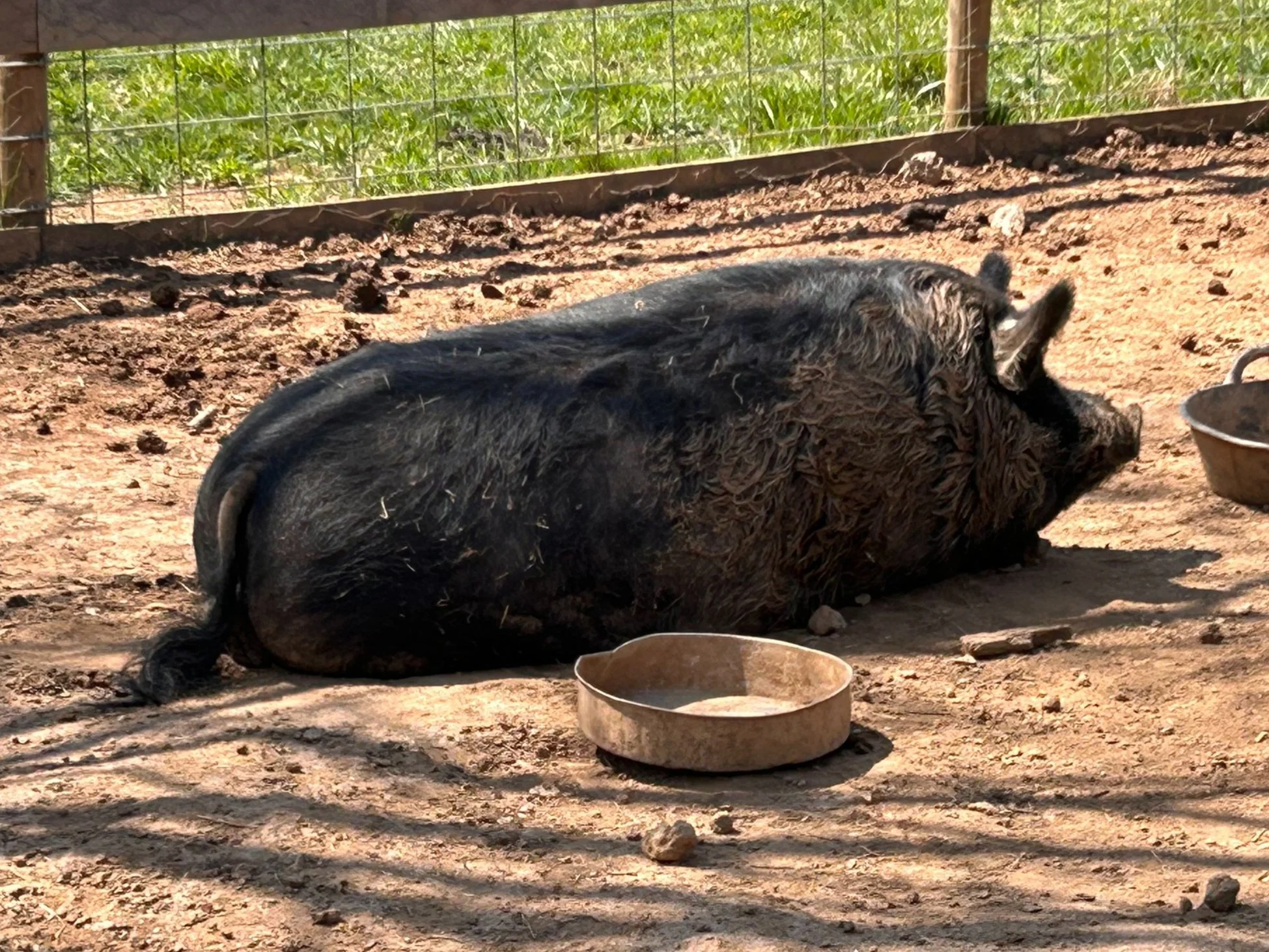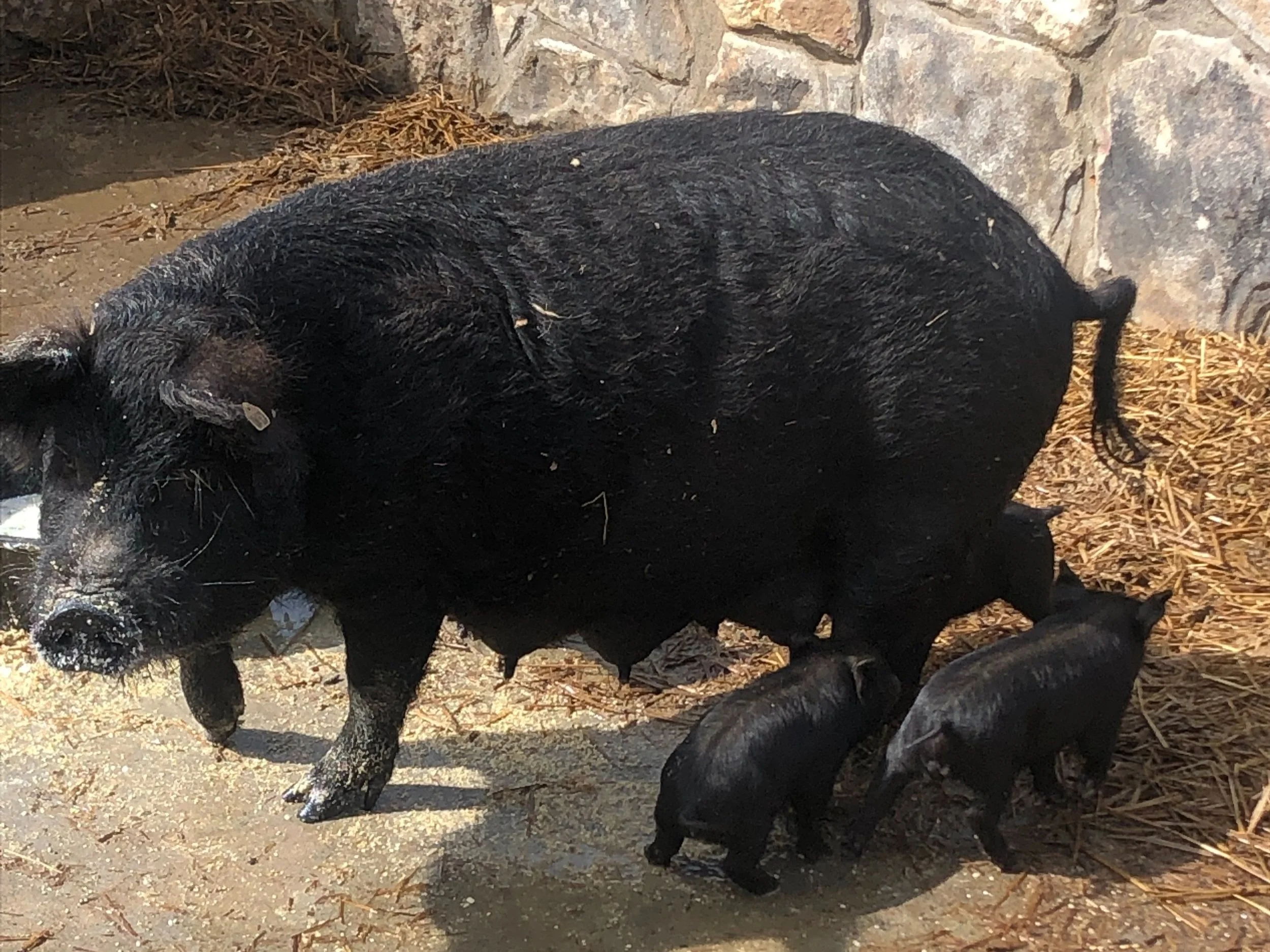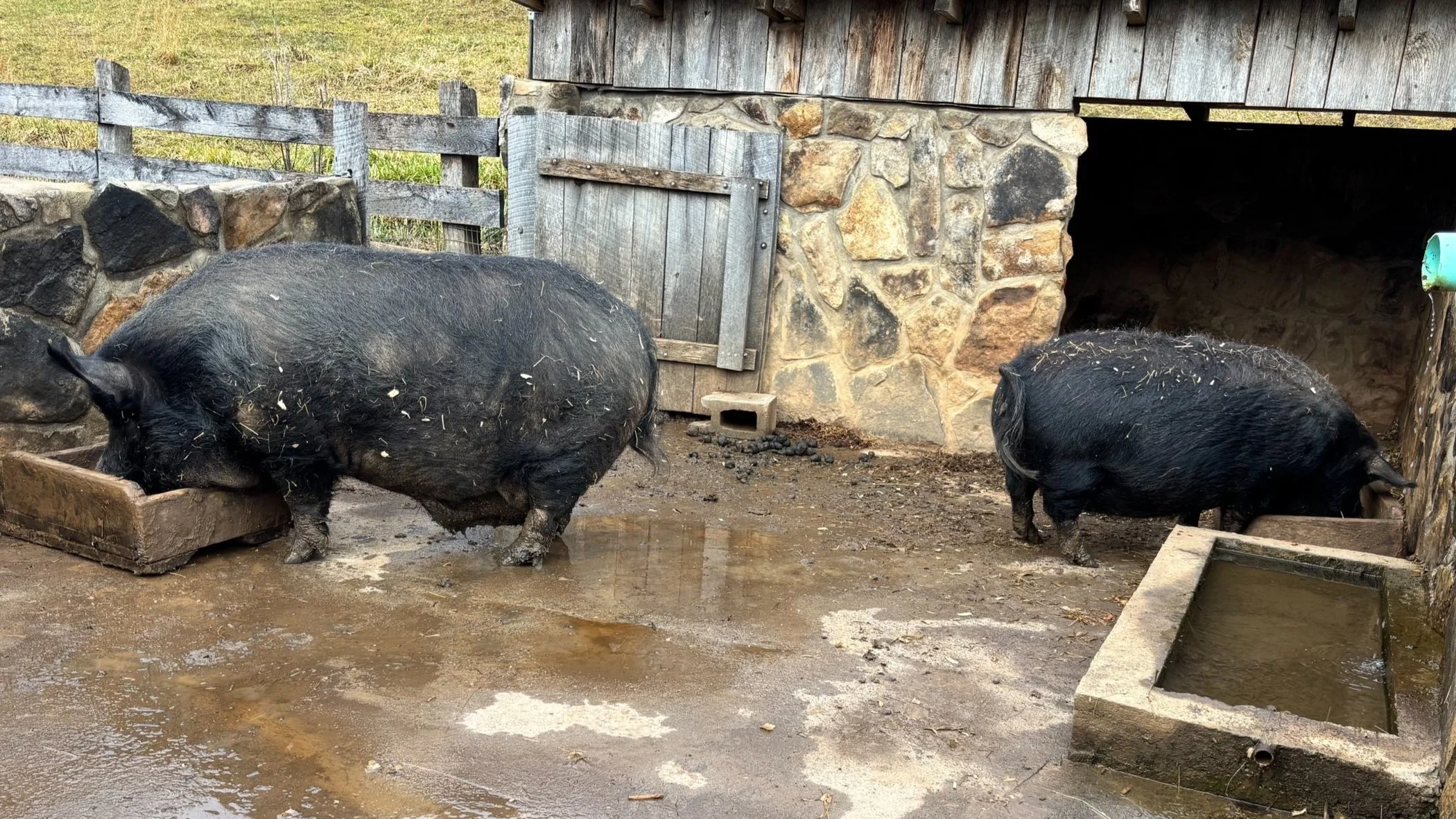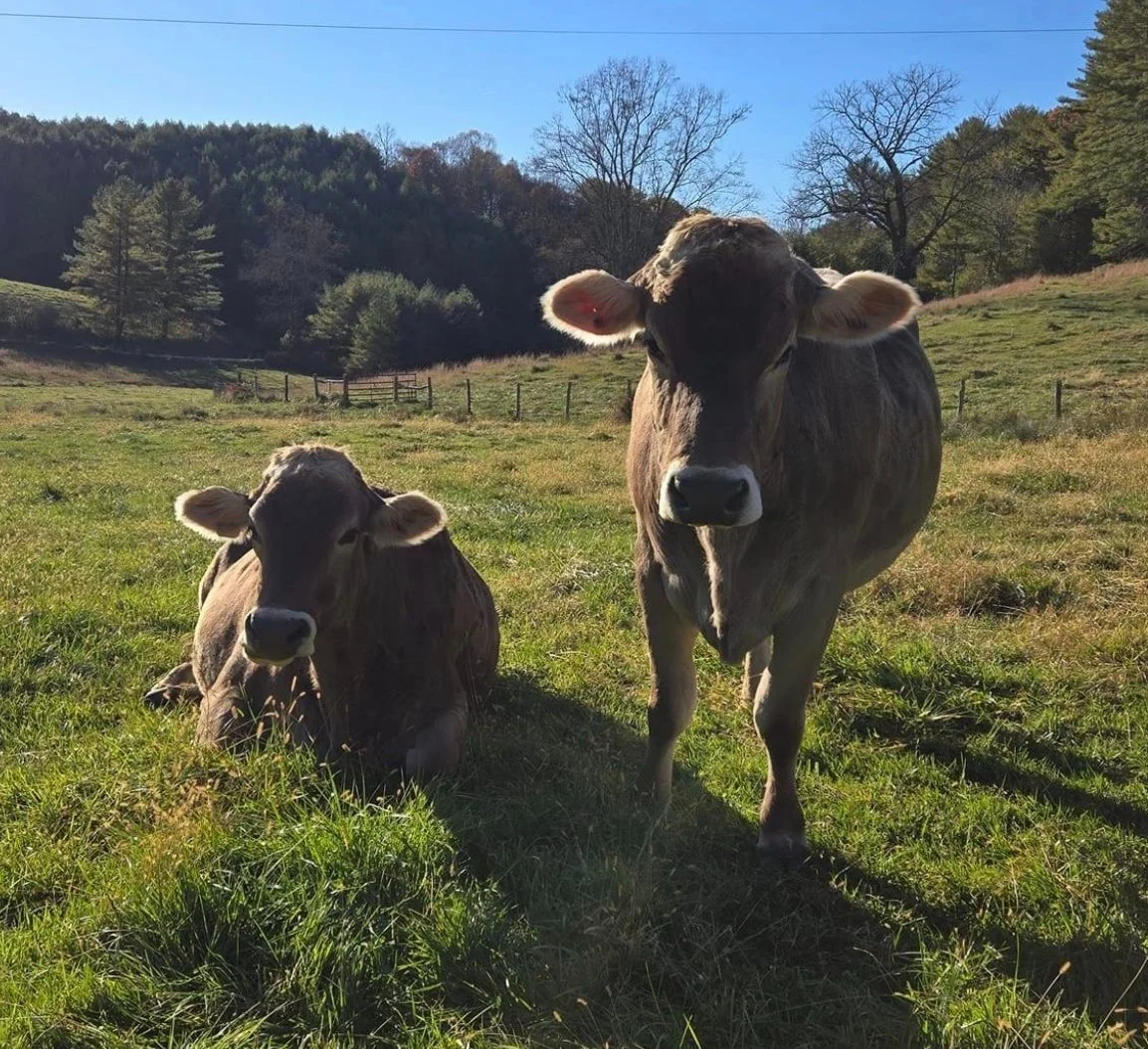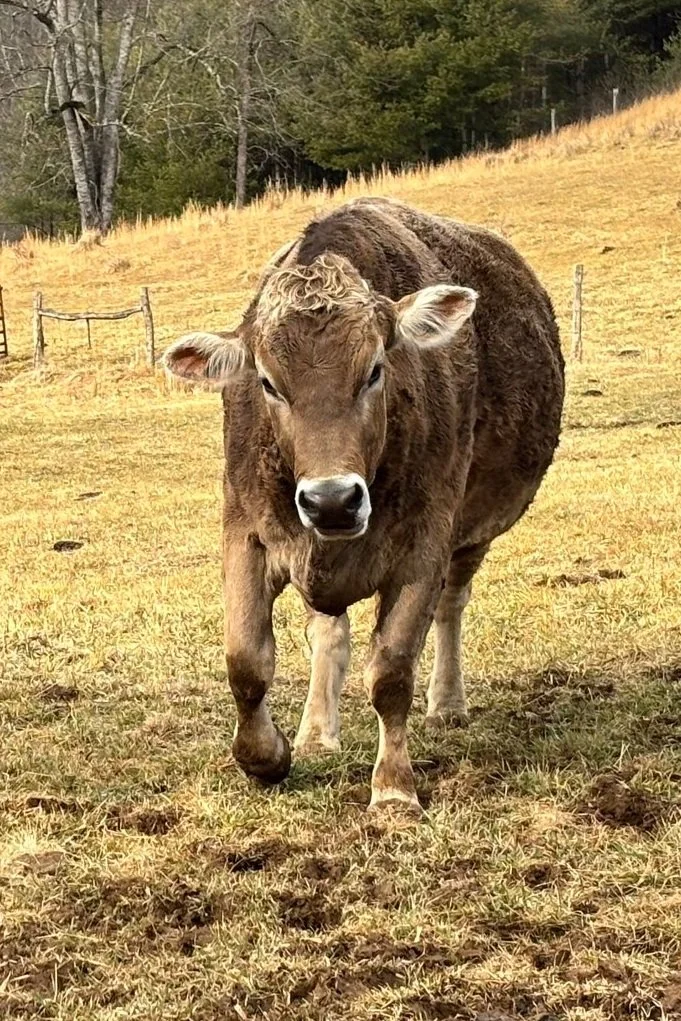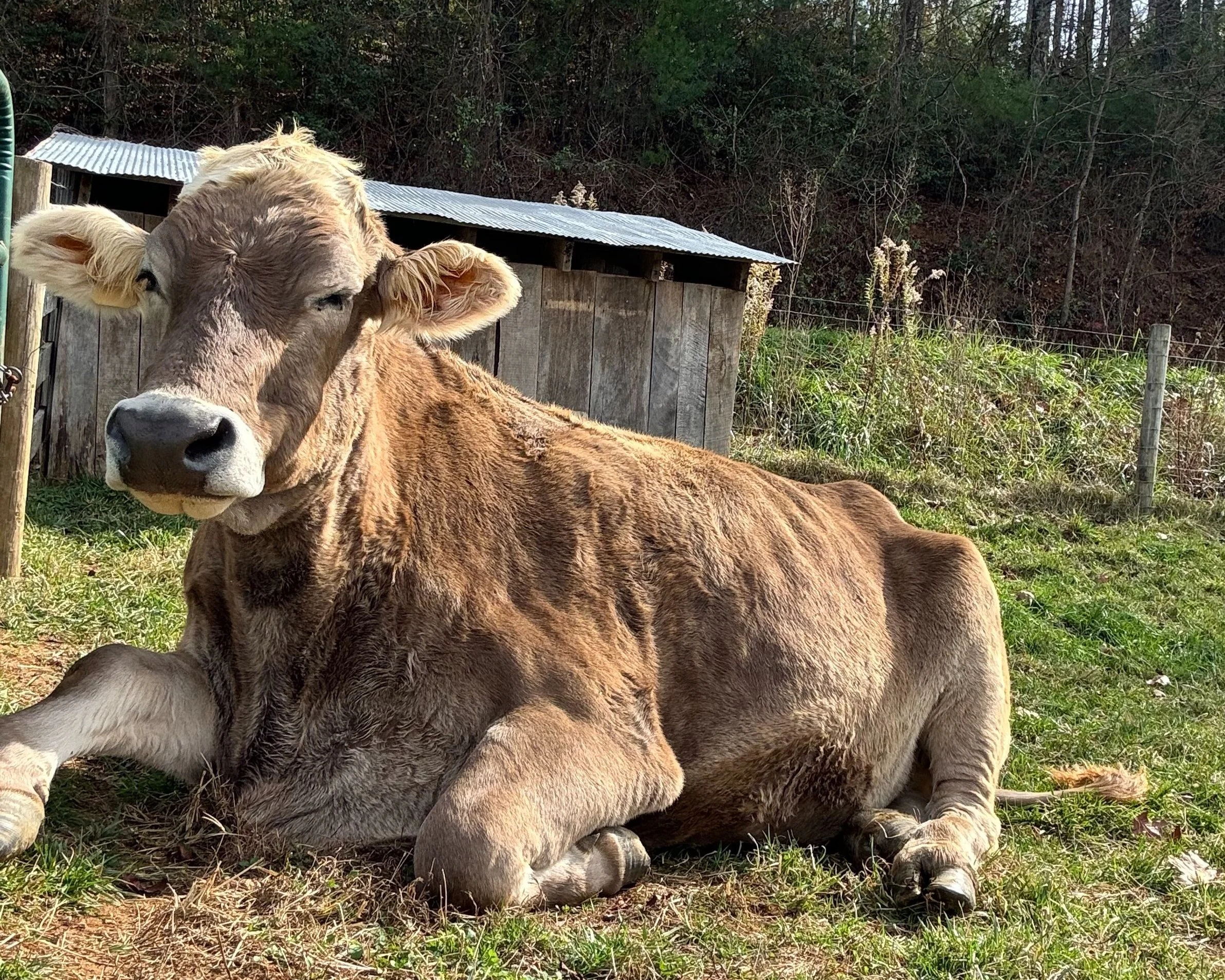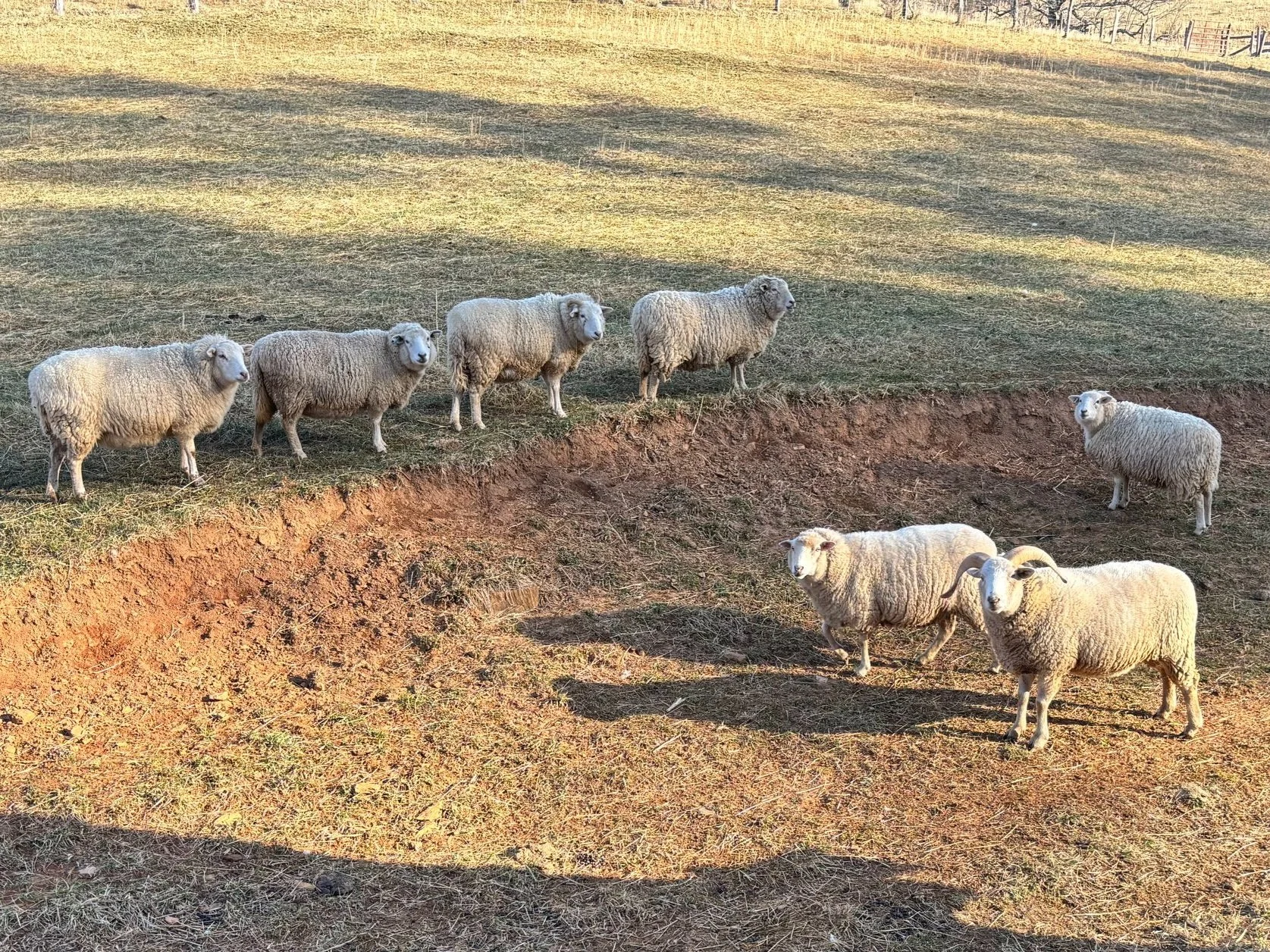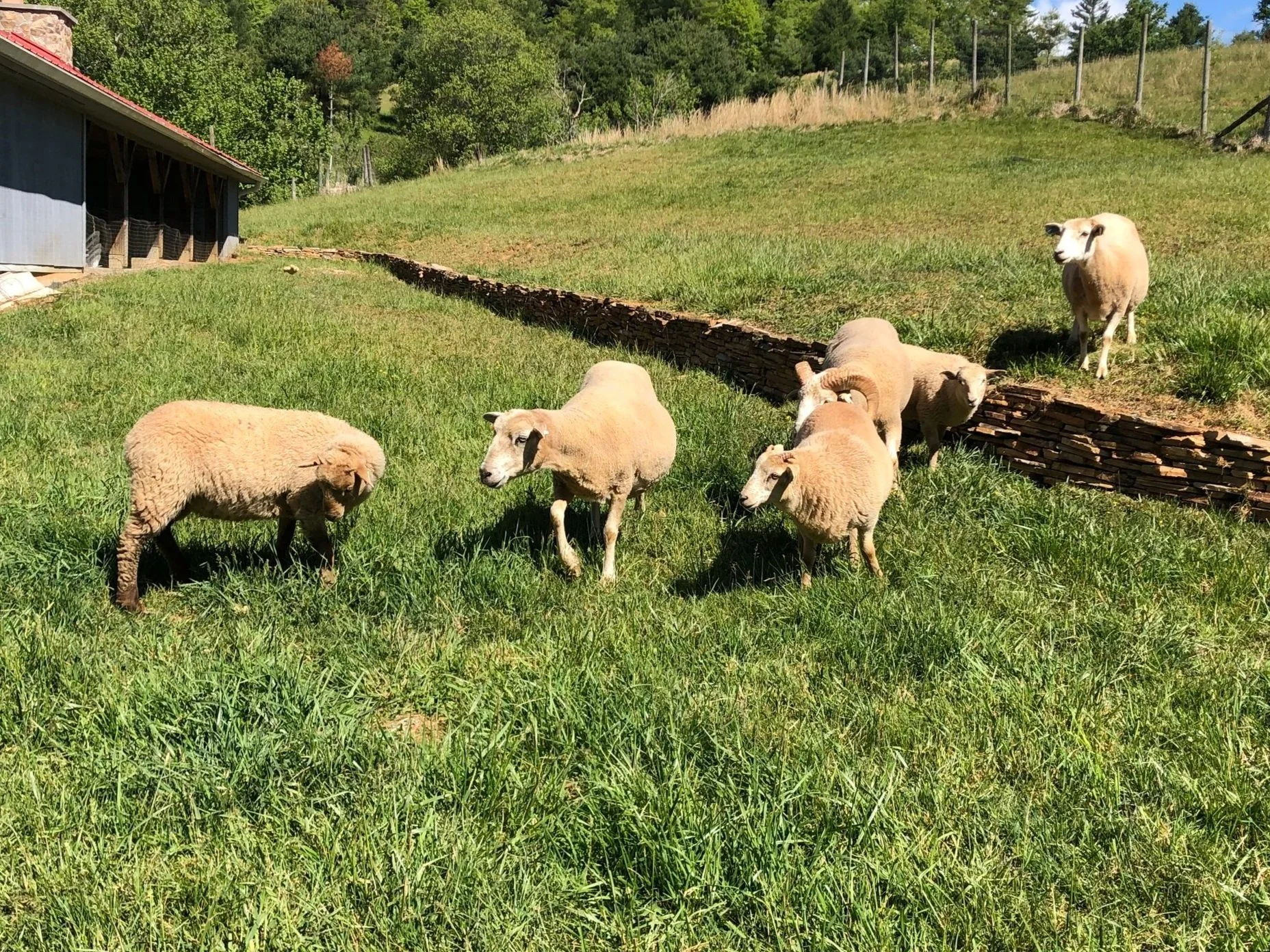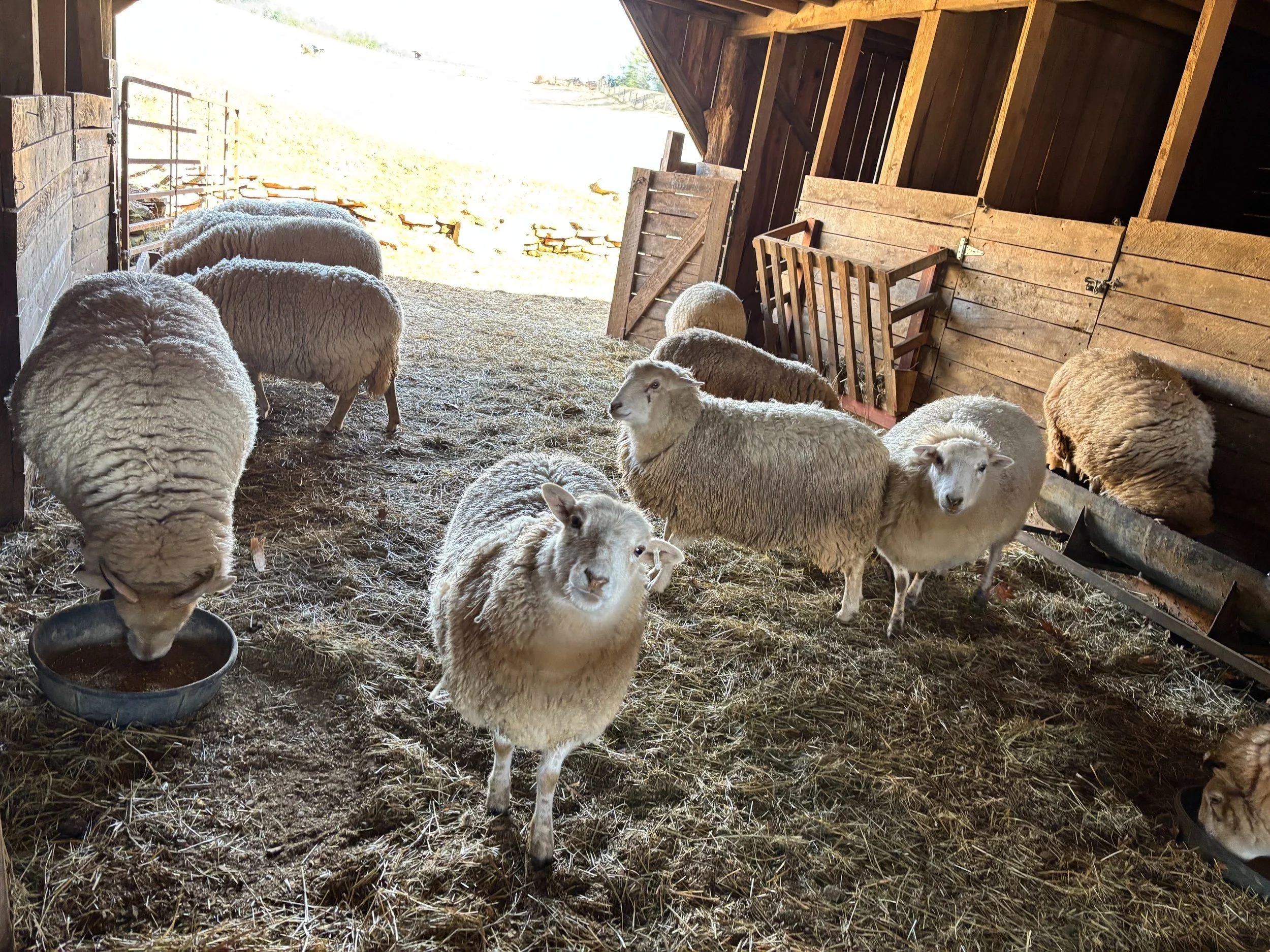American Guinea Hogs
What the Livestock Conservancy has to say about this breed. “The American Guinea Hog is a small, black, landrace swine breed unique to the United States. Written records indicate the presence of the Guinea Hog breed in the American South as early as 1811. After 1840, the Guinea Hog was likely crossed with the now extinct “Improved Essex”, a solid black pig from Essex County, England, that was developed in 1840. Documents from the period indicate that Essex pigs were imported to Georgia and cross-bred with local, coarser southern stock. The breed in America was referred to as American Essex.
Guinea Hog Boar
Breeding-up programs for pigs were highly encouraged in Agricultural bulletins at land grant universities. It is assumed that between 1845 and 1960, localized, unregistered Guinea Hog populations were enhanced and influenced by American Essex boars. The phenotype of an Essex hog in the late 1800s – based on drawings and description – is remarkably similar to the phenotype of some of today’s registered American Guinea Hogs.
Red Guineas – were imported to America, possibly from Africa, as early as 1804 by Thomas Jefferson and other colonial farmers. During this time, African slaves were also actively being imported, and the Red Guineas could have arrived on the same ships.
To further confuse the issue, an obscure Virginia community called “Guinea” exists today just 140 miles from Monticello where the Red Guineas were raised. There is little reason to believe that the large Red Guineas from 1804 are related to the black Guinea Hogs found in the United States as early as 1811. In fact, it is more likely that the Red Guineas were used to create the Duroc breed.
Prior to 2006, this pig was referred to as Guinea Hog, Guinea Forest Hog, or “Yard Pig.” In 2006 when the American Guinea Hog Association (AGHA) was formed, they changed the breed’s name to American Guinea Hog. It was known as the “poor man’s pig” and was raised on small farms in the Southeast. Unlike imported breeds, there was no consistent system of registration, herd books, or pedigrees retained on them consistently prior to 2006, although attempts to organize had been made in 1956, 1988, and 1990.
Sows will live up to 14 years and raise viable litters for 1-8 years. Some breeders have had a sow of age 10 or even 12 that produced viable litters. Boars will live, breed, and produce viable offspring to age 17. The longest living American Guinea Hog boar documented was in a zoo setting and lived to be 22 years old.
American Guinea Hogs are well-suited for raising in the forest or orchard, or on pastured land. Homestead owners can expect them to forage for much of their own food, including eating rodents, snakes, grass, roots, nuts, garden beds after harvest, orchard windfall fruit, and corn stalks. Breeders that raise milk animals may feed them excess milk or whey.
Guinea Hogs are hardy and efficient, gaining weight on the roughest of forage and producing the hams, bacon, and lard essential for subsistence farming. They grow fat when given grain, especially corn and soy. In most situations, a quart of feed twice a day will keep an adult boar, or sow with weaned young, in good condition; lactating sows with a litter require three to four times more feed. Generally, feeding sweet feed and corn will cause this breed to put on too much weight and become obese which negatively affects their fertility. It is important to monitor body weight and increase or decrease inputs as needed.
The breed is known for its intelligence, easy trainability to fencing and boundaries, verbal commands, and routines.”
If you would like to read the full article on this breed you can find it at https://livestockconservancy.org/american-guinea-hog/
Brown Swiss
The Brown Swiss you will meet at the Matthews Living History Farm Museum are steers and were started out to be a working team of Oxen. They have been raised on the farm from bottle babies and will be 8 years old this fall (2025). Gus and Gilbert are very sweet gentle giants. They love seeing people come in to see them and visit. You’ll find Gus usually with his girlfriend Henrietta. Gilbert is the third wheel with them but he usually comes up to the fence to say hi first.
History on the Brown Swiss
What the Brown Swiss Cattle Breeding Association has to say about the Brown Swiss cattle. “Originating in the Swiss Alps, Brown Swiss adapt well to high altitudes and hot or cold climates, while producing large volumes of milk, ideal for cheese-making. Their unique ability to yield high volume with an ideal fat-to-protein ratio sets them apart from other dairy breeds.
Brown Swiss cattle can be grey, dark brown, tan or even almost white in color. Their hooves, muzzle and switch are usually black. They are often noted for their docile temperament.
Perhaps the oldest of all dairy breeds, Brown Swiss originated in the valleys and mountain slopes of Switzerland around 4000 B.C., according to some historians.
Today, the beautiful Brown Cattle can still be found across the globe, including in the United States, where the largest concentration is in Wisconsin, Iowa and Ohio. The world population of Brown Swiss is reported to be about 4 million, which ranks either first or second in world-wide population of dairy cattle. The Brown Swiss you see grazing across the United States countryside descend from initial importations of 25 bulls and 140 females from Switzerland.
Brown Swiss are known for their docile, friendly disposition. On average, a Brown Swiss cows weigh about 1300-1400 pounds, while bulls weigh almost 2000 pounds! Brown Swiss are low-maintenance, high producing, adaptable cows that live a long time and make money for dairy producers. Brown Swiss withstand both hot and cold climates and thrive in a variety of terrains and management systems. Their longevity, dairy strength, and outstanding feet and legs make Brown Swiss cattle the obvious choice for modern dairy farms.”
If you would like to read the full article on the Brown Swiss you can find it at this web address: https://www.brownswissusa.com/about-us/bs-breed-facts
Gulf Coast Native Sheep
(Critically Endangered Breed)
What the Livestock Conservancy has to say about this breed. “Gulf Coast Native Sheep, Woods Sheep, and Native Sheep, descend from the Spanish flocks brought to the New World by explorers and settlers beginning in the 1500s. Their genetic origins aren’t known, since a wide variety of types and breeds of sheep existed in Spain at that time. Churro Sheep, multi-purpose animals used for meat, milk, and coarse wool, were commonly brought to the Americas by the Spaniards, however, and may have contributed to the breed’s foundation. At the same time, the Gulf Coast’s fine wool suggests a contribution from pre-Merino types as well.
Gulf Coast Native Sheep were used across the Southeast by Spanish missionaries, Native Americans, and European settlers as far north as the Carolinas. Spanish Sheep in the Southeast were shaped primarily by natural selection, becoming well adapted to the heat and humidity of the environment.
These sheep fit their challenging environment so well that for centuries, they were the only sheep to be found in the deep South, providing wool and meat for home production. The development of anti-parasite medications in the 1900s allowed the introduction of other, larger, more productive sheep breeds to the Southeast. Gulf Coast Sheep were slowly discarded by most farmers; the breed was saved only through the action of a few Southern families.
Gulf Coast Sheep lack wool on their faces, legs, and bellies, an adaptation to the heat and humidity of the South. Otherwise, they tend to vary somewhat in aspects of physical appearance. Variability has also resulted from the isolation of different strains of the breed. While most sheep are white, blacks and browns also occur, and some individuals may have spotted faces and legs. Most rams and some ewes are horned, although both sexes may also be polled. Gulf Coast Sheep vary in size, with rams weighing 125 to 200 pounds and ewes 90 to 160 pounds.
What is consistent among Gulf Coast Sheep is their exquisite adaptation to an environment that is generally difficult for sheep. Gulf Coast breed and lamb year-round. The ewes make excellent mothers, pasture lambing without assistance. Ewes usually produce 70 percent single births, 30 percent twins, and rarely triplets. With good forage, the incidence of multiple births increases. The lambs are vigorous and grow rapidly. Gulf Coast Sheep have well-documented resistance to gut parasites, foot rot, and other diseases that commonly affect sheep. These valuable performance characteristics recommend the breed for low-input sheep production.
Like other landrace breeds, the Gulf Coast has suffered from a lack of documentation and description. Researchers at the University of Florida and at Louisiana State University have addressed this problem by working to locate breed populations and describe the breed’s characteristics. Additionally, since 1995 private efforts have been underway to inventory and register Gulf Coast Sheep across the Southeast.”
You can find the full article on the Livestock Conservancy website: https://livestockconservancy.org/gulf-coast-sheep/


